From the late Eric Brandreth’s collection of articles typed ready for publication in the Society Newsletter. This account of Kinsbourne Green was written in 1991 and Geoff Woodward has sent us updates and amendments. Further updates added in 2018.

Annotated copy from 1924 OS map showing position of The Kennels, and the Wernher Recreation Room
The pubs
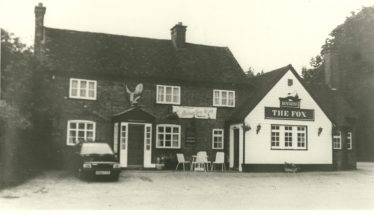
The Fox, c. 1970
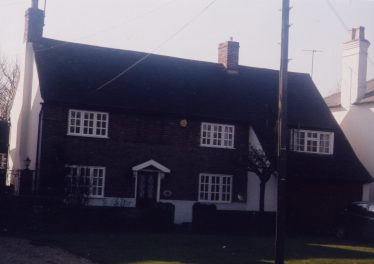
Whip Cottage – the Whip until 1935
Several old buildings still stand at Kinsbourne Green. The focal point of the community was the pubs. The Fox was known as the “Smyth Arms” in 1710, until that family left Annables Manor in 1914. It then became known as the Fox. The bar on the left was for many years a butcher’s shop. It was also the meeting place for the hounds of the Hertfordshire Hunt, which were based at the Kennels.
Close by, a little further south, was The Whip which was built in 1780 as a house for the Landseer (Head Gardener) of the Luton Hoo estate. It was rather grand for a cottage – it had two downstairs rooms and three beamed bedrooms, a scullery and a washhouse. Its land extended south to the blacksmith’s (see below). From around 1840 it was sold to a hat making company in Luton, and operated as a plait school. In around 1900 it became an ale house, possibly gaining its name from serving customers waiting for their horses to be shod at the nearby blacksmith’s. During the Great War the pub also ran a small grocery store. However in 1935 it reverted to a house known since then as Whip Cottage (information from Lynne Slater in 1999).
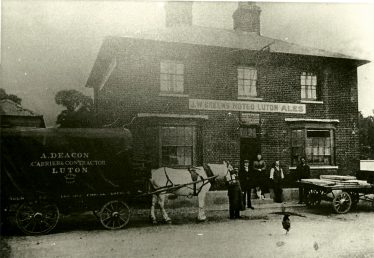
The Harrow, c.1900

The Harrow, c.1990
Across the road stood The Harrow, known to be there in 1887 as they had a fire in the roof that year. For many years it had been the turning point for late-running 321 buses. However, its end as a local pub came in 1980 when, after extensive alterations and extensions, it re-opened as a Beefeater on 2 December 1980. The interior even included a working water wheel (with no natural source of water). The restaurant was renamed ‘The Peppercorn’ at the end of 2002. There was a Mr Peppercorn at Thrales End Farm at one time, but I was told that was only a coincidence. A year later it was ‘The Green’, to be followed in 2011 by ‘Zara’. Currently it is ‘Charlies’. However in 2015-16 planning permission was granted by South Bedfordshire Council for the restaurant and associated out-building to be demolished and replaced by a terrace of Edwardian style houses.

The site of the First and Last pub was a little further along, through a gap in the hedge, where daffodils still flower in the spring. Kennels cottages are in the background.
By the nature of its position, the fourth pub on the length of Luton Road was known as The First and Last as it stood halfway between The Fox and the Kennels by the New Mill End turning. The building, latterly a house, was demolished in 1974 and only a gap in the hedge and a few daffodils in Spring indicate its location.
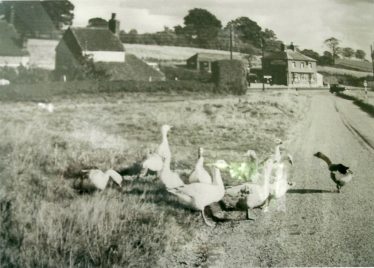
Geese on the Common
The Blacksmith’s
Now called Rose Cottage, the house on the corner of the Common and Luton Road was originally a blacksmith’s. It was run by William Swain who came here from Hatfield and ran it until his death in 1892, when it became a house. The family lived in The Cottage next door to the smithy.
The Water Pump
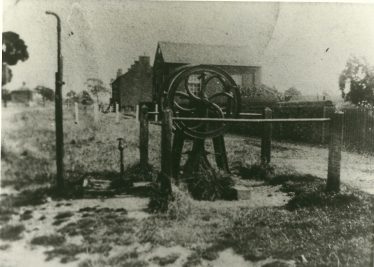
Well and Water pump
Water was drawn from a very deep well close to Luton Road, almost outside Whip Cottage. In January 1905 a large hand operated pump was installed at a cost of £90 but was described as “quite useless and was very hard to operate”.
St Mary’s Church and School
This was built in 1869 as a combined church and school and opened on 8 April 1869; a new classroom was added in 1892.
In the 1950s the school meals arrived in a green van each day, still hot. When they failed to arrive, a coach would come and take the children to Batford School for dinner there. In 1950 one class walked to the River Lea at East Hyde, paddled in the river, had a nature lesson and managed to get a lift back to school in a Lyons bread van. The school closed in July 1955 when the pupils transferred to the new school at Roundwood Park.
New house building in the area saw a rise in the number of people attending the church and in June 1968 work started to lengthen the nave, whilst a new porch and vestry were added. The former classroom became the church hall and a new kitchen and toilets were also built. It was re-dedicated on 19 December 1968.
The School
Early Days
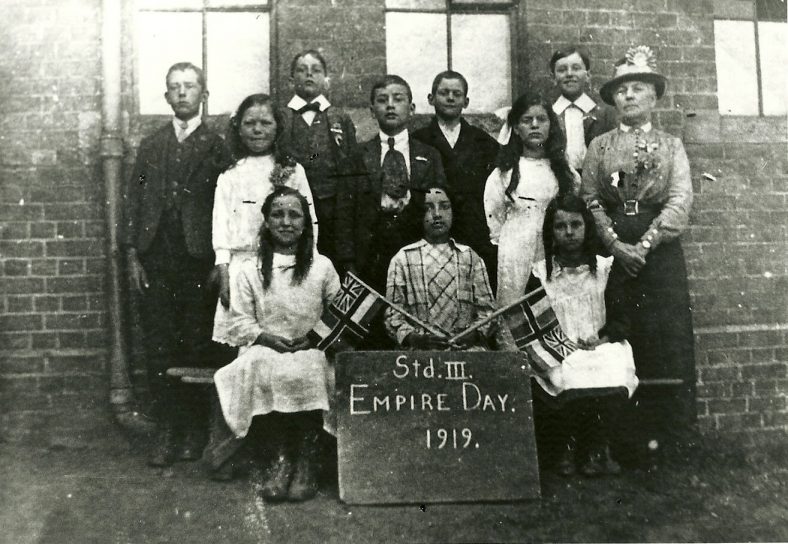
Empire Day 1919 – Standard III at St Mary’s school
The 1950s and closure
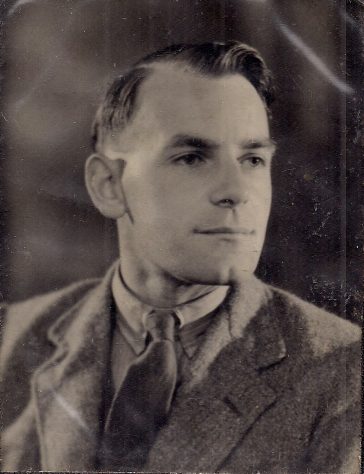
Geoffrey Ginn, headmaster of Kinsbourne Green JMI school c1950 – 53
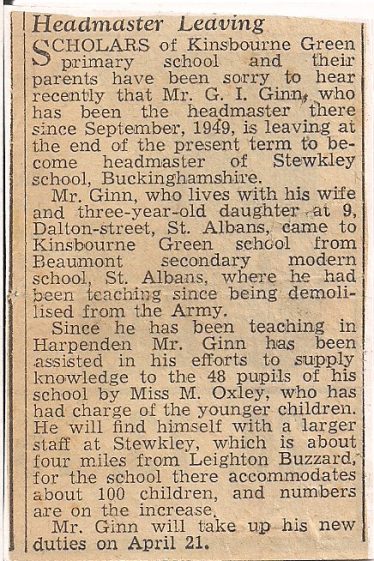
Newspaper report of Mr Ginn leaving Kinsbourne Green
Geoffrey Ivor Ginn was born in Bedford, trained at Durham and was headmaster at Kinsbourne Green from September 1949 until April 1953.
After army service in bomb disposal; the medical corps and as a volunteer paratrooper at D-Day, he completed his teacher training and then taught at Beaumont School, St Albans before becoming headmaster at Kinsbourne Green. His next challenge was to be headmaster at the larger school at Stewkley where he stayed for the rest of his career. He died there in 1961.
The school closed in 1955

The staff in the centre: no.33: Mrs Large; 34: Mr R W Smith, headteacher; 35: Mrs Oxley.

Kinsbourne Green School, pupils and staff in 1955, compiled by Sue Woodward in 2011. Amendments to spelling of names and the details based on scrutiny of the School Roll by Alan Haines in 2021 – together with correction to no.49: unknown girl, but not Ruth Haines, and addition of no.55: Kenneth Harris.
Amendments to the names in the key to the 1955 photo, as recorded in the School Roll:
2: Robin Brown; 3: Marylin Wendy Harper; 6:Gaye Parsons; 10: Julia Norris; 13: Ann McMillan; 19: Brian Copperwheat; 26 Marilyn Fearne; 29: Rachel Claire Corbett; Elizabeth Ruth Catton; 37: Anthony Lunn; 41: Gordon Thackray; 45: Sheelagh Norris; 47: Mary Elizabeth Allingham; 48: Carol Jane Allingham.
A full history of St Mary’s by R O Bradbury, with a postscript by Fred Pointon can be found on the church website at http://parishofharpenden.org/StMarysHistory.html
The Scout Hut
The 9th Harpenden Scouts were based at the Luton Road Mission Hall at 110 Luton Road until March 1971 when they had to leave. They were granted a 99 year lease on a plot behind St Mary’s Church on which they erected a temporary building given by the National Westminster Bank. It was opened on Saturday 18 April 1973 by Ian Fulton. This prefabricated building is being replaced by a permanent building during the winter of 2013-14.
The Methodist Church
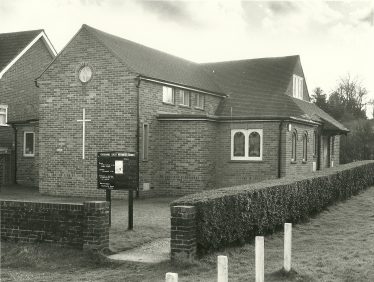
Methodist Church, Kinsbourne
In 1856 three Luton Wesleyans paid £5 for a plot of land on which they built a small church. It was destroyed by fire soon afterwards and another was built on the same foundations. A new hall was added in 1931 to the rear of the church. The old building which came right to the front of the site became unsafe and was demolished in October 1949 and a new chancel designed by George Herring, built and completed in 1951. The church records before 1939 were lost when snow found its way through the roof of the vestry in 1951.
The last service was held on 28 April 2002 due to falling numbers. There was a meeting on 2 December 2002 to decide on accepting an offer and it was subsequently sold to developers on 15 April 2003. Demolition was completed in June 2006 and houses were built on the site.
The Kennels
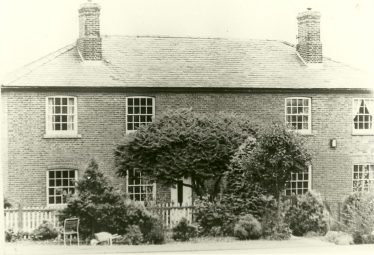
Kennels Cottages, 1987
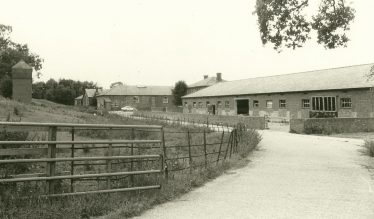
Kinsbourne Green kennels – dairy farm 1991
At the Luton end of Kinsbourne Green stand the Kennels. They were re-built in 1866 and building only took four months. They housed the hounds belonging to Luton Hoo. In March 1876 Mrs Leigh of Luton Hoo offered the use of the Kennels and the Huntsman’s House to the Hertfordshire Hunt and they accepted, remaining there until 1939 when they transferred to Houghton Regis as a wartime measure. The site was used during the war as an Ordnance Depot. Work started in May 1950 to convert the buildings into a dairy for Luton Hoo estate and was completed in November the same year. It has recently ceased to be a working farm and is now being converted into barn residences.
The Wernher Rooms
Almost next door to The Fox was a hall built by Lady Wernher of Luton Hoo as a working men’s club. A wooden hut with a tin roof opened on 1 October 1908. It was also used for a Christmas party every year for the schoolchildren at St Mary’s and it was said that the children got more in presents at the party given by Lady Wernher than they got at home, a sign of how poor the families in the area were at the time.
It was used as a store during the Second World War, fell into disrepair and was pulled down soon after.
Shops
Apart from the butcher’s shop at The Fox, already mentioned, there was a grocery shop run by Charles Westley in the last house, Broadway, from about 1914 to 1927.
In 1927 Bennets opened a grocery shop and Post Office at 433 Luton Road, although latterly it became a piano showroom and then a publishing firm. From 1932 – 1952 the Harris family ran a grocery shop in the front room of their house at 417 Luton Road (The Cottage).
The shops at The Pavement were built in 1937 and have seen several uses and owners over the years, including the Post Office transferring to one when Bennets closed at 433. Whilst the owners have changed, the end shop was a hairdresser’s from when it was built until it closed in March 2004.
The Cabin (381 Luton Road) next door originally sold produce from the market garden behind the shops; when that closed it became a newspaper shop for a while, then a bookshop, and currently (2018) the offices of MediaPrint. When the grocery shop closed in the late 1980s, Green Lawns Garage stepped in and, after the closure of their café, altered the premises to provide a grocery shop.
When the Post office at 105 Luton Road Post Office within the grocery shop near Park Mount was closed in April 2004, the Post Office at The Pavement became the main one for the whole of north Harpenden – described as part of an improved service!
The Garage
Green Lawns garage was built about 1930 and soon established itself as a meeting place for touring car owners and cycling clubs. The main building was a tea room and behind were tennis courts which opened in June 1937. In April 1938 an 18 hole golf course was added. Whilst the golf course was short-lived, the tennis courts were in use until the early 1950s.

Green Lawns garage
Frank Pratley, the owner from 1960 to 1977, acquired a steam ploughing engine and for ten years this was to be seen around the area or parked on the garage forecourt when not in use. He took it away when he left in 1977. Steam engine rallies were a regular event.
The café had been closed during the war but reopened in October 1946. Later, in April 1960, it became an Espresso Coffee and Hamburger Bar, and soon settled down as a transport café. It was also used by the bus drivers on the 321 route, as many buses terminated here rather than Luton, the hard standing on the corner of Common Road providing space for turning and parking. The café closed on 23 December 1989 and was converted into a shop.
Bowers Motors took over the garage in August 1981 and started selling motor caravans as well as running a garage. Bowers garage closed in October 2000. Soon after the site owner started selling petrol again on a very intermittent basis (Jet petrolium), until finally closing in 2008.
The former garden beside the garage was used by Marquis Auto Homes from April 2001. This closed at the same time as the petrol station. Demolition followed, and new houses were completed in 2012.
The Market Garden
The area behind the Pavement shops and Green Lawns Garage was a market garden for many years, started by Mr Catton and known as Kinsbourne Nursery. This was run by Mr Henry Perry until he took it over in 1938 and it became known as Perry’s. It provided produce for his shop in the High Street as well as The Cabin, the little shop by Luton Road where produce was also sold. Mr Perry went to Australia in 1951 and Mr Robert Allingham took over, still supplying his shop in the High Street and The Cabin.
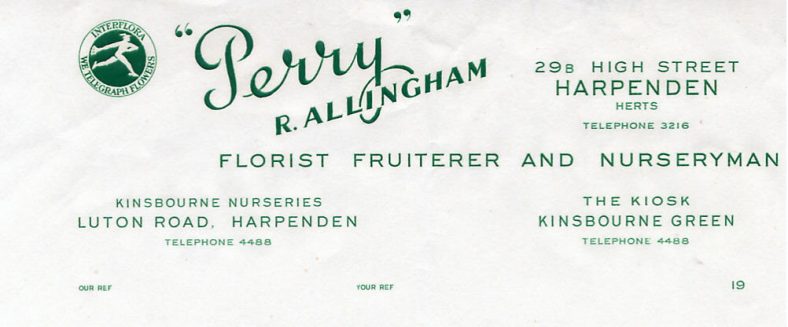
Letterhead, 1950s
In 1968 the site was sold to the builders Pearce and Barker for redevelopment of what is now Kinsbourne Close. The Cabin remained as a bookshop, having seen several different uses in the past.
The Poultry Farm
Leylands Chicken Farm moved from Harpenden Rise to the top of The Close in about 1936. Miss Cain kept Rhode Islands and White Wyandottes as well as five geese and some ducks. By 1952 it was known as Kinsbourne Poultry Farm until about 1964, when it moved away.
The Harpenden Sign – 1991
At the end of 1991 the rough standing by the garage and the corner of Common Road was grassed over and proper parking bays put in for cars. In the centre of the grassed area, a “Harpenden” sign like the one on Harpenden Common was erected on 11 December 1991 to mark the 60th Anniversary of The Harpenden Society.
Flooding
The A1081 Luton Road continues to flood in heavy rain. Some half-hearted efforts were made to solve this problem when the road was resurfaced in August 2005.

Comments about this page
The First and Last pub was turned into 2 cottages one of which was, in the late fifties and early sixties, the home of my grandparents Fred & Phyllis Mangham . The address was 10 First and Last. In the other cottage was a Mr Pinney.
The information about the Kennels states the Kennels were built in 1866. I wonder whether there was a Kinsbourne Green Kennels there before, as an entry in the 1851 Census shows my great grandfather there as a groom (HO 107 1713).
Ed. Thank you for drawing this to our attention. We have contacted researchers of the Luton Hoo estate, who confirm that there had been hunting on the estate from the C18. So the kennels must have been rebuilt – and we have corrected this in the text above.
Information about Mr Ginn, headmaster at the school from 1949 to 1953, received from his daughter Sue Malleson, has been added to this page.
I live at one of the 3 houses built on the site of the Methodist Church. 4 or 5 of the original “cornerstones” dating from the 1850s remain and are incorporated in the paving by the front doors.
Most interesting site. Two things I have always understood differently. Concerning the photograph LHS archives-cat No 3781 (LFC) – I and my family lived there at the time it was taken in 1987. I always understood them to be huntsman houses and always spoken of as Kennels Cottages; the actual farm house is in the area where the kennels themselves used to be in the farm yard.
As for the public house, the First and Last, I had been told it was so called as it was the last when leaving Hertfordshire and the first when coming over the border from Bedfordshire, but I accept I may have been misinformed.
ed. Thank you for your correction. We have amended the caption.
Geoff Woodward adds:
Plans for “Highland”, Kinsbourne Green, to be converted into flats in 1951-52, were designed by architect W H Guest Hubbard of 35 Manchester Street, Luton.
Littlefields (the former apple farm) was built in 1939 by H S Gray, builder.
Add a comment about this page